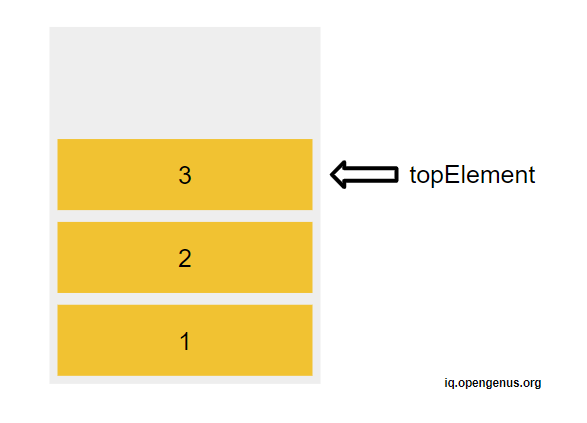
Open-Source Internship opportunity by OpenGenus for programmers. Apply now.
In computer science, data structures play a vital role in organizing and manipulating data efficiently. One such data structure is the stack. A stack is an abstract data type that follows the Last-In-First-Out (LIFO) principle. JavaScript, being a versatile programming language, provides built-in support for implementing stacks. In this article at OpenGenus, we will explore the stack data structure in JavaScript, understand its underlying principles, and learn how to implement and utilize stacks effectively.
Table of Contents:
- The Basics of a Stack
- The Role of the Call Stack
- Implementing a Stack Class
- Advantages of Stacks
- Conclusion
The Basics of a Stack
At its core, a stack is a collection of elements with two primary operations: push and pop. The push operation adds an element to the top of the stack, while the pop operation removes the topmost element from the stack. This behavior resembles a physical stack of objects, where the last item placed on top is the first one to be removed.
In JavaScript, we can implement a stack using an array or a linked list. Let's start by using an array as the underlying data structure. Consider the following code snippet:
const stack = [];
// Push operation
stack.push(1);
stack.push(2);
stack.push(3);
// Pop operation
const topElement = stack.pop();
console.log(topElement); // Output: 3
In the above example, we create an empty stack represented by the array stack. We then perform three push operations, adding elements 1, 2, and 3 to the stack. Finally, we execute a pop operation, which removes the topmost element (3) and assigns it to the topElement variable.

The Role of the Call Stack
In JavaScript, stacks are not only used for organizing data, but they also play a crucial role in the language's execution model. JavaScript has a call stack, also known as the execution stack or program stack, which keeps track of function calls during program execution.
Every time a function is called, a new frame (also known as an activation record or stack frame) is pushed onto the call stack, storing information such as the function's arguments, local variables, and the return address. When a function completes its execution, its frame is popped from the call stack, and control returns to the previous function.
Consider the following example:
function foo() {
console.log("Hello from foo!");
bar();
}
function bar() {
console.log("Hello from bar!");
}
foo();
In the above code, when foo() is called, its frame is pushed onto the call stack. Inside foo(), the bar() function is invoked, causing its frame to be added to the top of the stack. The execution order is as follows:
- Push
foo()frame onto the stack - Log "Hello from foo!"
- Call
bar() - Push
bar()frame onto the stack - Log "Hello from bar!"
- Pop
bar()frame from the stack - Pop
foo()frame from the stack
Understanding the call stack is essential for debugging and analyzing JavaScript programs. It helps developers trace the flow of execution and identify errors such as stack overflows (when the call stack exceeds its maximum capacity).
Implementing a Stack Class
While using an array to implement a stack works perfectly fine, it can be useful to create a custom stack class with dedicated methods for push, pop, and other stack operations. This approach provides encapsulation and abstraction, making the code more readable and maintainable.
Let's create a simple Stack class in JavaScript:
class Stack {
constructor() {
this.items = [];
}
push(element) {
this.items.push(element);
}
pop() {
if (this.isEmpty()) {
return null;
}
return this.items.pop();
}
isEmpty() {
return this.items.length === 0;
}
size() {
return this.items.length;
}
peek() {
if (this.isEmpty()) {
return null;
}
return this.items[this.items.length - 1];
}
clear() {
this.items = [];
}
}
In the above example, we define a Stack class with an array items as the underlying data structure. The class includes methods such as push(), pop(), isEmpty(), size(), peek(), and clear(), which correspond to the fundamental operations of a stack.
Using the Stack class, we can rewrite the previous example as follows:
const stack = new Stack();
stack.push(1);
stack.push(2);
stack.push(3);
const topElement = stack.pop();
console.log(topElement); // Output: 3
Advantages of Stacks
Stacks offer several advantages in various programming scenarios. Here are a few benefits of using stacks:
- Managing function calls: Stacks are instrumental in managing the execution of functions in programming languages. The call stack ensures that function calls are handled in the expected order.
- Undo/Redo functionality: Stacks are commonly used to implement undo/redo operations in applications. Each action is pushed onto the stack, allowing users to revert changes or redo previously undone actions.
- Depth-first search: Stacks are used in graph traversal algorithms, such as depth-first search (DFS). The stack keeps track of the nodes to be visited, ensuring the algorithm explores the graph's depths before backtracking.
- Parentheses matching: Stacks are useful for solving problems related to parentheses matching. By keeping track of opening and closing parentheses, stacks can ensure the validity of expressions.
Conclusion
In conclusion, understanding the stack data structure is crucial for any JavaScript developer. Whether it's organizing data, managing function calls, or implementing algorithms, stacks provide a powerful and efficient way to handle various programming tasks. By leveraging the built-in array or creating a custom stack class, you can harness the full potential of stacks in JavaScript and build robust and elegant solutions to a wide range of problems.
